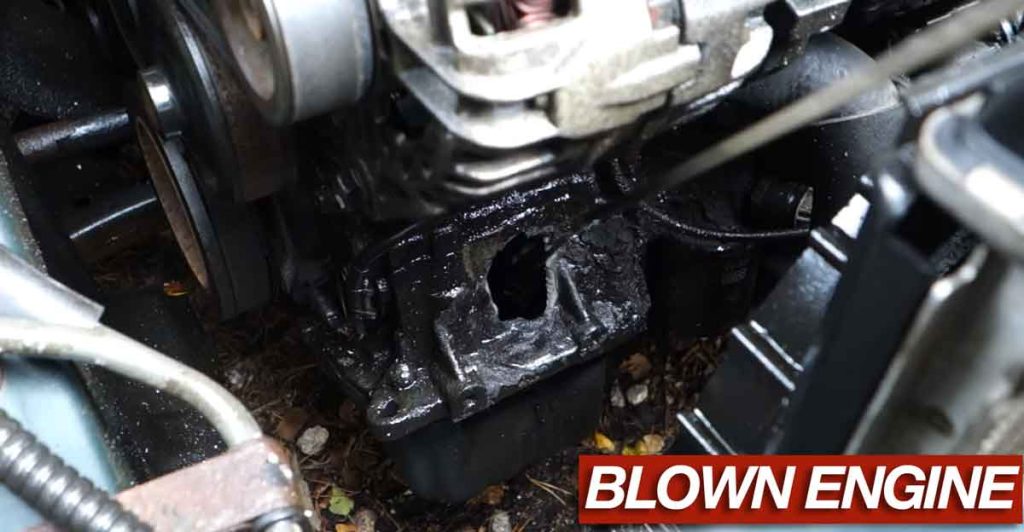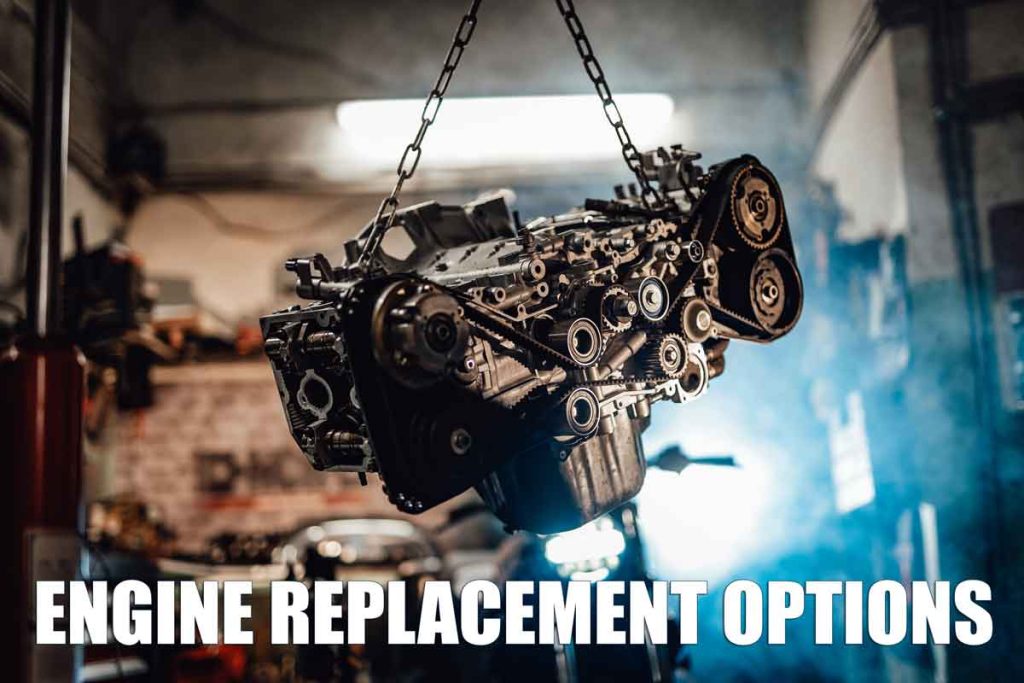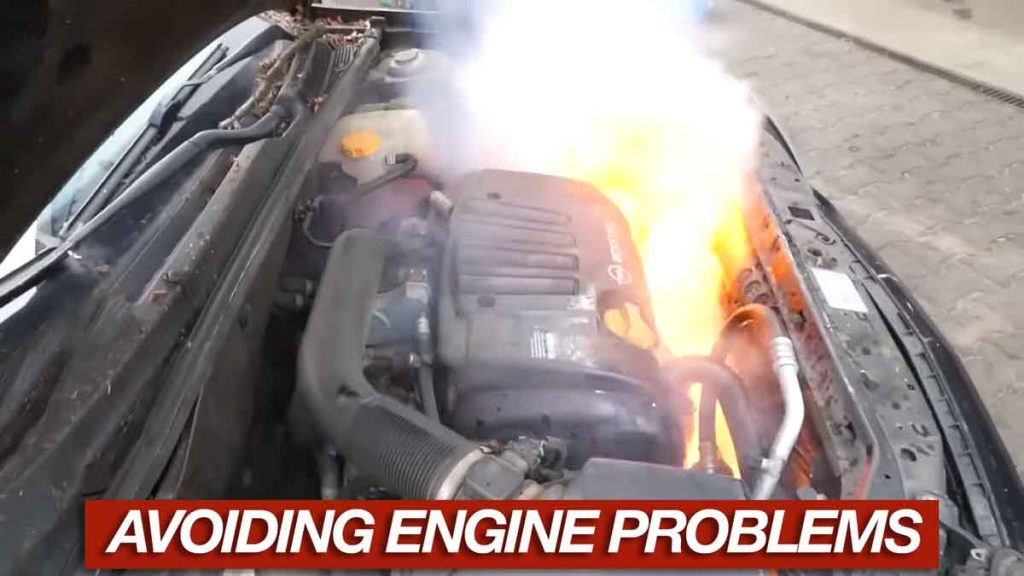Search Our Local Junkyards Database
When your car's engine breathes its last, the cost of a new one can hit your wallet hard. Opting for a Blown engine replacement from a junkyard, regardless of whether it's the pistons, valves, or head gaskets, can be a viable option. might be a savvy solution that aligns with your budget and needs. This approach saves you significant money and recycles parts, which is better for the environment. By choosing this route, you'll navigate the challenges of finding a reliable engine while ensuring it’s compatible with your vehicle—crucial steps towards getting back on the road efficiently.

Recognizing a Car with a Blown Engine
Recognizing a car with a blown engine is an essential skill for any car owner, as it equips you with the knowledge of when to seek auto repair, or in severe cases, to consider if it's time to sell your car. Several telltale signs can be observed to tell if your engine is blown. A car engine blow could manifest as the emission of excessive smoke from the tailpipe or severe knocking noises emanating from the engine.
You might also find coolant in the engine oil, indicating that the head gasket has possibly failed to pressurize. An immediate inspection by an auto repair expert is essential under such circumstances.
A broken engine can result from a faulty timing belt, which, if not addressed in a timely manner, escalates the damage to a blown engine. Knowing if your engine is blown enables you to make informed decisions rather than incurring hefty repair costs or selling a car at a loss. In essence, understanding what a blown engine means is crucial to mitigating the financial and safety risks associated with the continued operation of the vehicle.
Symptoms and Causes of Engine Failure
If you notice your car is losing power, it could be a symptom of engine trouble. This loss might feel like your vehicle is struggling to go or stay at speed. Also, unusual noises from the motor area often mean something's wrong. A knock or clank can signal serious failure.
Overheating can lead to an engine blowing up. If your car gets too hot, it may stop working right or even get damaged inside.
Initial Diagnostics
The check engine light on your dashboard is important. It means you should look into what's happening with your car's motor. To find out more, perform a compression test on the engine cylinders to see if they're working as they should.
It's wise to talk with a mechanic for their expert opinion on what’s going on with your car’s motor.
Identifying Signs of Car Engine Problems
Watching for blue smoke coming out of the exhaust pipe helps spot oil burning issues in the motor which isn’t good news for any vehicle owner; this usually indicates that oil leaks into places it shouldn't be within the motor and gets burned up during operation.
Another bad sign is finding metal shavings mixed in with the oil when checking under the hood – this points towards internal damage that needs fixing fast before things get worse! Lastly, if turning the key doesn't start up your ride anymore then there could very well be some serious problems under that hood needing immediate attention!

Blown Motor Replacement Options Explored
New Engines
When you choose a new engine, you're getting the latest model with no wear. These motors come with manufacturer warranties which means they are protected if something goes wrong soon after installation. However, be prepared to pay more for these brand-new replacements. Investing in a new engine also means expecting a longer lifespan for your vehicle. This is because everything in the engine is fresh and untouched by previous use.
New motors mean peace of mind but remember, the cost can be quite high. It's not just the price of the engine itself; it may include additional costs like installation and possibly modifying bolt holes or trans components to fit perfectly.
Rebuilt Engines
A rebuilt engine might be your middle ground option. The engine with problems has been taken apart, cleaned, the worn head gasket, pistons and valves replaced, before being put back together. This process makes them reliable again without costing as much as new ones do.
Rebuilt motors often come with limited warranties that offer some protection but less than what new ones provide. They strike a balance between cost and reliability, making them an attractive choice if you want to avoid the steep price tag of a new engine swap.
Used Engines
Lastly, there are used engines from junkyards around you, which could save you money upfront compared to other options. You'll find these at lower prices because they've been previously driven — mileage and wear will vary greatly.
However, keep in mind that used engines typically have shorter warranty periods or none at all. When considering this route, it's crucial to check the junkyard inventory and the motor condition carefully before deciding on this most cost-effective option.
Always weigh out how much life is left in them against how much longer you plan on keeping your car running smoothly without major issues.
Cost Analysis of Engine Replacement
Labor Expenses
The cost to replace a blown motor is not just about the parts. Labor expenses can take up a big part of your budget. Mechanics charge different rates. This depends on where you live and how skilled they are. It's smart to ask several shops for quotes. This way, you can find the best price for the work needed.
Some mechanics specialize in certain car brands or models. They might charge more but do better work on your specific vehicle type. Make sure you check their experience with engines from junkyards too.
Parts and Additional Costs
When planning for a motor replacement, there's more than just the engine cost itself. You'll also need other parts like belts and gaskets. These should be new to ensure everything runs smoothly.
Sometimes, putting in a different engine means making changes to your car. This could add extra costs as well. Don't forget about things like oil and air filters either! Your “new” engine will need fresh fluids to start off right.
- Get quotes from multiple mechanics.
- Choose someone experienced with junkyard engines.
- Remember additional parts like belts and gaskets.
- Prepare for possible modifications to fit the new engine.
- Include fluid and filter replacements in your budget.

Understanding Engine Warranties
Coverage Details
When your engine fails, you may think about a blown engine replacement from a junkyard near you. Before you do, check if your warranty or insurance Your car manual covers this, including how to recognize and remedy engine failure or problems with the combustion process. It is crucial to read the fine print of your coverage plan. This tells you what parts and services are included.
- Verify coverage for used engines.
- Look for specifics on part and labor inclusion.
- Understand deductible costs upfront.
You need to know how much money comes out of your pocket before starting.
Some plans cover only new parts, while others might accept used ones like those from junkyards. Knowing the deductible amount is also key. This is what you pay before insurance helps with costs.
Junkyard Guarantees
Junkyards can be good for finding cheaper parts but be careful. Some offer guarantees on their used engines. Always ask about these guarantees first.
- Inquire about return policies after installation.
- Check guarantee duration and conditions.
- Remember that labor costs might not be covered in these guarantees.
If something goes wrong after installing the engine, it's important to know if you can return it. But remember, most times they won't pay again for labor if reinstallation is needed.
After considering cost analysis from the previous section, warranties add another layer to think about. They can save money or cause headaches later on depending on their terms.
Comparing Engine Types
Combustion Performance vs Standard
When your engine fails, you face a choice. Do you pick a car with a blown engine and attempt to repair it, or look for a replacement? performance engine or stick with standard specifications? If speed, power, and the perfect combustion sequence excite you, performance engines might tempt you. But remember, they often need extra changes to fit right.
On the other hand, standard replacements match what was originally in your car. They are easier to install because everything fits like it used to. You won't have as many surprises during the process.
Performance engines can be thrilling but think about cost and work before deciding.
Power and Durability
Now let's talk about power output and durability. Rebuilt engines may offer more power than used ones from a junkyard. But this isn't always true.
Used engines vary in quality due to age or wear. A high-mileage motor could mean less oomph when you hit the gas pedal.
- Consider how long each option will last.
- Think about whether an older engine has enough power for your needs.
A rebuilt engine might run like new longer than one that's just been pulled out of another car. Choosing between them means weighing immediate gains against future reliability.
Choosing the Right Engine
Common Engine Compatibility Factors
Before you pick a blown engine replacement from a junkyard, make sure it matches your car. The engine must fit your vehicle's make and model. This is crucial for a smooth swap.
You also need to check if it works with your car's transmission system. Not all engines work with every transmission type. Make sure both parts can talk to each other properly.
Lastly, confirm that the electronic interfaces align with your current systems. If they don't match, you may face issues later on.
- Ensure engine fits your vehicle's brand and design.
- Verify that the new engine and transmission are compatible.
- Check if electronic connections will work without problems.
Interchangeability Considerations
Sometimes different engines can fit into your car with some changes needed. You should research which models are interchangeable. This could save you time and money.
But be careful! Some swaps might void any warranties on your vehicle. Always double-check this before making decisions.
- Look up which engines can replace yours with minor tweaks.
- Be aware of warranty risks when switching engines around, especially when dealing with head gasket or exhaust valve components.
Sourcing from Junkyards
Local Junkyard Search
You might find a blown motor replacement by visiting local junkyards. Here, you can see engines with your own eyes. This helps you check their condition closely. Ask about how often they get new parts. A high turnover rate means fresher engines might be available.
At the junkyard, remember to talk about prices. You can often negotiate them down if you know the engine's condition and local demand.
- Look for signs of wear or damage.
- Check for rust or missing parts.
- Ask workers for any recent arrivals.
Salvage Yard Benefits
Salvage yards are like hidden gems for car parts. They're great places to find rare items that aren't made anymore. Plus, things here usually cost less than at stores or dealerships.
Buying from salvage yards also means helping out nearby businesses which is good for your community’s economy.
Here are some benefits:
- Lower costs compared to new parts.
- Chance to find unique pieces no longer in production.
- Support local business growth and sustainability.
What you need to check when buying a used engine from a junkyard,
When buying a used engine from a junkyard, there are several critical factors you ought to check keenly. Start by examining the engine block to identify any signs of damage, like cracks, that could substantially diminish the engine’s functionality.
The condition of engine oil is also paramount. If you notice coolant in the engine oil, it could be a red flag indicating internal engine problems like a blown head gasket. Furthermore, carefully inspect the complete engine to find any significant issues, like a broken valve, that may necessitate a complete engine replacement later on.
Take a closer look at the internal engine; specifically, check for possible damage or poor maintenance in the combustion chamber where the internal combustion process occurs. An improperly maintained combustion chamber can cause the car engine to blow, leading to costly repairs.
Lastly, don't forget to examine peripheral parts of the engine like the water pump, which plays a crucial role in preventing the engine from overheating. Always remember, purchasing a used engine should offer the advantage of essential cost reductions. If the state of the engine from the junkyard warrants huge repair costs, it’s advisable to consider a new engine, which can offer peace of mind in terms of reliability and warranty coverage.
Post-Replacement Maintenance
After securing a blown engine replacement from a junkyard, your focus should shift to maintenance. Proper care will ensure the longevity of your new engine.

Routine Checks to Avoid Engine Issues
You must perform routine checks to avoid future issues. Check oil levels and quality often. Dirty or low oil can harm your engine quickly. Make sure you also monitor the coolant levels regularly. This helps prevent overheating, which could damage your replacement engine.
Keep an eye on the temperature gauge during operation as well. If it reads too high, stop and check for problems immediately.
- Regularly check: the condition of your head gasket, exhaust valve, connecting rods, and any other potential signs of engine failure.
- Oil level and quality.
- Coolant level to prevent overheating.
Watch temperature gauges closely while driving.
Warning Signs
Pay attention to early warning signs of engine problems such as knocking sounds or fluid leaks. These could be hints of serious trouble ahead if ignored.
Address small issues right away before they grow into big ones that cost more money and time. Remember, ignoring them might lead you back to another blown engine scenario.
- Heed these early signs of potential engine failure: excessive smoke, overheating, or an engine that won’t start.
- Unusual noises like knocking.
- Visible fluid leaks under the car.
Don't wait; fix small problems promptly.
Special Cases for Classics
Authenticity Issues
When you find a car with a blown engine, consider your next steps carefully. blown engine replacement from a junkyard, check every part. Some parts may be fake. Fake parts can break your engine again. Always ask if the part is real before buying it.
- Look for signs of original branding.
- Ask for proof of where the part came from.
- Compare the engine part to pictures in a magazine – look at the valve, piston, or head gasket carefully. Reading a car magazine can help you identify symptoms of a blown engine, the role of a piston, or how a head gasket works. or online.
Using real parts keeps your classic car running well and safe.
Compatibility Challenges
After putting in a new engine, make sure everything works together. Your car's computer might not understand the new engine right away. This can cause problems.
Here's what to do:
- Test all electronic systems after installing the engine.
- If something doesn't work, get help from an expert quickly.
This helps avoid bigger issues with your car later on.
Selling a Car with a Blown Engine to a Junkyard or Salvage Yard
When you are faced with the catastrophic – and visual – sight of smoke billowing from beneath your car's hood, it's an unnerving sign of major engine trouble. In the worst case, this could be a total engine failure, a clear indication of engine damage that in many instances, renders the vehicle unfit for use. Indeed, the harrowing sight of a motor blown to the point of causing thick smoke emissions, accents the severity of the situation.
Now, the once valuable possession seems to be misled in its worth, yet certain vehicles may still hold significant value. For instance, some junkyards or salvage yards are interested in buying such cars, especially if you aim to sell a non-running car. They may buy the vehicle to salvage other parts, even if the engine is beyond repair.
It's important to comprehend what your car is worth and identify potential buyers committed to ensuring effective communication. Although selling a car with a blown engine can be a daunting task, these yards might present a reliable solution for your incapacitated vehicle.
Summary
You've navigated the complexities of replacing a blown engine, weighing options and costs. Now you know about warranties, engine types, and the nitty-gritty of sourcing from junkyards. Post-replacement maintenance isn't just a suggestion—it's your ticket to ensuring that your chosen engine, be it the pistons, valves, or connecting rods, thrives under your care. For those with classic rides, special considerations have been laid out to preserve the soul of your machine.
Take action now—don't let a blown engine stall your life. Roll up your sleeves, find that diamond in the rough at a junkyard, and get back on the road with confidence. Share this guide with fellow gearheads facing engine failure challenges and drive the conversation forward. Your car's revival starts with a turn of a wrench; let's get to it.
Frequently Asked Questions
How can I tell if my engine is blown?
A blown engine typically presents with loud noises, smoke from the exhaust, power loss, or complete failure to start. Immediate professional diagnosis is recommended for engine problems, especially if it's a persistent knocking sound or connecting rod issue.
Is replacing an engine with one from a junkyard reliable?
Junkyard engines can be a cost-effective solution but vary in reliability. Ensure it's inspected and comes with some form of warranty for peace of mind.
What costs are involved in replacing a blown engine?
Costs include the replacement engine itself, labor for installation, and any additional parts needed. Prices range significantly based on these factors.
Do engines from junkyards come with warranties?
Some junkyards offer limited warranties on used engines; always verify the terms before purchasing.
How do I choose the right replacement engine from a junkyard?
Match your vehicle’s make, model, year, and ideally find an engine close in mileage to your original one. Consult a trusted mechanic if unsure.
What maintenance should be done after installing a junkyard engine?
Change all fluids, replace filters and spark plugs, inspect belts and hoses for wear-and-tear post-installation to ensure longevity of the replacement engine.
Are there special considerations when replacing an engine in classic cars?
Yes. Authenticity matters for value preservation; sourcing period-correct or refurbished original engines is often preferred over modern replacements.

